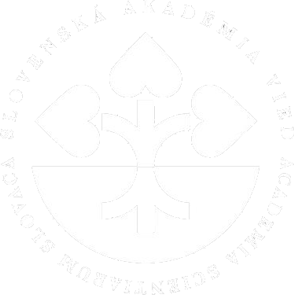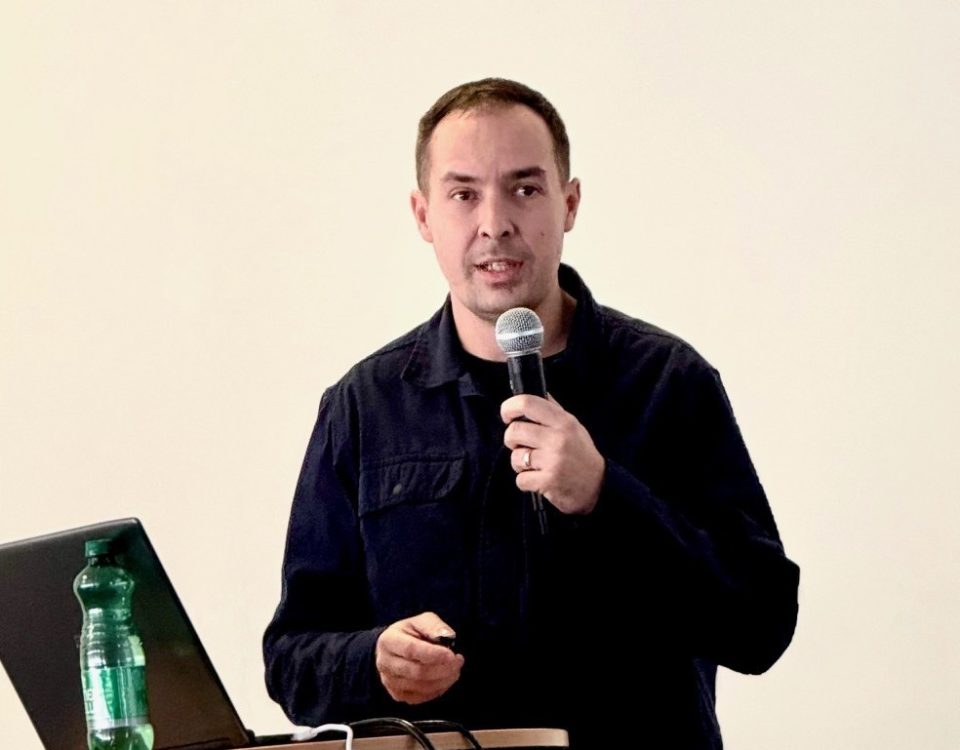This website uses cookies so that we can provide you with the best user experience possible. Cookie information is stored in your browser and performs functions such as recognising you when you return to our website and helping our team to understand which sections of the website you find most interesting and useful.
Scientific cafes in Košice celebrated their 10th anniversary
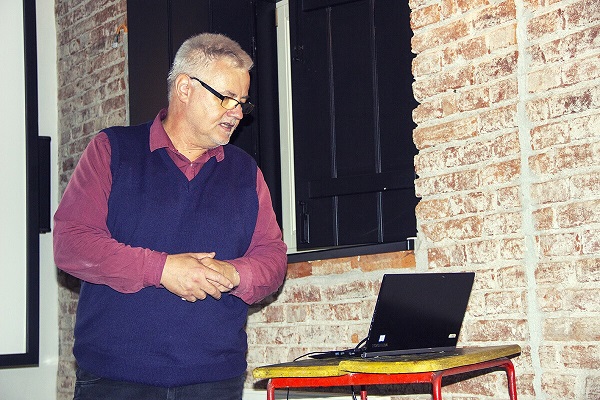
RNDr. Ján Gálik, CSc., vedecký riaditeľ Neurobiologického ústavu Biomedicínskeho centra SAV v Košiciach
The November scientific café in Košice with the climate change topic was a jubilee one. The topic, which currently resonates in society and is highly topical, revealed a view of climate change from a pragmatic engineering perspective. Ing. František Simančík, PhD. from the Institute of Materials and Machine Mechanics SAS in Bratislava and a member of the SAS Presidium, offered an exact view of an expert – an engineer on possible causes of change, and did not miss realistic options for humanity to respond to change without having to go “back to the caves”. With his lecture Dr. Simančík concluded the 10-year existence of scientific cafés in Košice. Historically, the first scientific café in Košice was held thanks to the APVV project, in December 2009 and the main lecturer was the leading Slovak biochemist MVDr. Jozef Burda, DrSc. from the Institute of Neurobiology SAS. The first café introduced visitors to the topic of induced tolerance of nerve tissue, which is actually a method of protecting nerve tissue after damage by mobilizing the internal mechanisms of the tissue.
A mastermind of the idea to popularize and present science and research to the general public through scientific cafes, RNDr. Ján Gálik, CSc., Scientific Director of the Institute of Neurobiology BMC SAS in Košice told us how it all came about, where the idea came from and what the visitors managed to learn in ten years.
“The first idea of a scientific café did not arise either in Košice or in Slovakia. Science cafes, or better known as Science café, are a phenomenon that has been around the world for some time. Slovakia lagged behind in this area and at the same time neglected contact with the public. It seemed to us that it was a pity. After all, we are financed from public finance and therefore the community should have the opportunity to get to know what we do in science”, said RNDr. Ján Gálik, CSc.
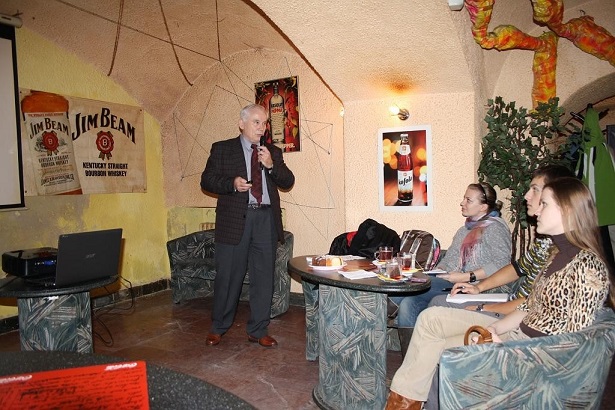
Prvá vedecká kaviareň v Košiciach, november 2009
However, opening up and bringing science closer to the public has not been the only main goal since the beginnings of scientific cafés in Košice. “The second or secondary goal was for us scientists. We felt the need to learn to interpret our thoughts and results in an interesting and understandable way to the general public, which is sometimes quite difficult. It is necessary to formulate ideas without technical terms that the public does not have to understand, and we have basically found that it is sometimes more difficult to make a contribution to a science café than to a science conference.”
During the existence of scientific cafes, the interest of visitors, as well as the society-wide climate brought the third goal, a message in the form of pointing out real values and real celebrities. “We have shown, and still show people, that people who deserve their title are walking on the sidewalk around them, whether in Košice, Bratislava or other cities. In science cafes, visitors learn facts, as well as information through critical thinking, right form the first hand. So it is not indirectly, but from the real person who works with it, who devotes his whole life to it, who works with scientific methods. “
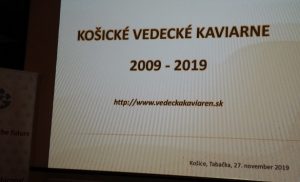
Košické vedecké kaviarne
Topics of scientific cafes… Medicine, radiology, physics, biology, art, economics, information technology, genetics, botany, issues of the eight years, cosmic physics, musicology, astronomy, astrophysics, history, issues of the Carpathian Germans, and many other topics have been heard in recent ten years in scientific cafes in Košice.
The scientific director, and especially a mastermind of the idea of scientific cafes in Košice, also recalled exceptional events related to presented topics.
“I don’t want to absolutize it, because each of the topics was really very good. For me, cafes were exceptional when people from the Institute of Social Sciences or the Institute of History came and stood in front of the audience without a presentation, they started talking and the audience was not breathing. I’m a natural scientist and not a social science scientist, so I’m not used to this kind of conversation, but it was amazing. It was a long discussion. Personally, I especially remember children’s questions. Children sometimes had really amazing questions that someone can surprise. They had a huge overview and interest in the topic. But there were also cafes, which were generally a little more prominent. For example, a week after the Philae module landed on a comet from the Rosetta spacecraft, we had the designer Ján Baláž, who worked on the communication part of this module, in the science café. It was hot information, it was in all the world’s media and we had him in a cafe, which was cool. Or the theme of gravitational waves or the universe. Both themes were presented by Assistant Professor Gális from the Institute of Physical Sciences PF UPJŠ in Košice. The gravitational waves, their significance, and their discovery were introduced by Assistant Professor Gális the day after the collision of the neutron star that caused the gravitational waves was documented. Two days after the very first photograph of the black hole, Assistent Professor Gális spoke about the mentioned universe. Or a topic about cryptocurrencies. Usually there is a stable number of visitors at the cafes, but in this case we had to move to a larger room due to a huge interest. So these are themes that were extremely up-to-date and people were very interested in it.” As RNDr. Jan Galik, CSc. said you cannot predict this… 🙂
And what topic will start another decade at the nearest scientific café in Košice? Let’s be surprised on December 18, 2019…
More information about scientific cafes in Košice
……………………………………………………..
Main theses of dr. František Simančík’s lecture on “Does our local comfort have to cause a global problem? Climate change through the eyes of an engineer “
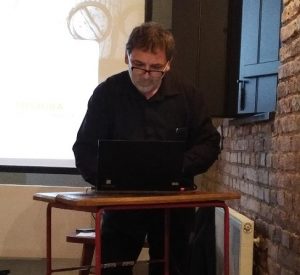
prednáška Ing. Františka Simančíka, PhD., november 2019
About two hundred years ago, people discovered an energy pantry underground. They began to eat it up happily, while they radically became fat (from about one billion to today’s seven). Moreover, believing that there was enough supply of suitable energy, they became lazy in their search for alternatives and paid more attention to their own comfort. However, the pantry is gradually being emptied and the consequences of our overeating leave such strong traces in the area that if we do not wake up early and start working hard again, we will not avoid radical weight loss. And maybe it’s; too late. Our behavior must therefore be radically reassessed immediately, while technical progress still provides good prepostitions so that we do not have to pay an excessive price for satisfactory comfort in the future.
These topics were also addressed in the lecture, which also pointed to the paradox of our persistent efforts for increased comfort, which, however, is likely to result in extreme environmental problems. The lecture focused mainly on the problems of obtaining and using the appropriate energy needed for human life in terms of its long-term security, which must also guarantee that humanity will survive in terms of other environmental aspects. From the point of view of sustainability, there was also insight into various concepts of providing humanity with the necessary energy – from fossil fuels, through technical methanol, solar electricity, “green ammonia” or technical hydrogen. Some interesting technical solutions for solar energy storage developed in Slovakia, which can contribute to reducing our dependence on fossil fuels, were illustrated on practical examples.
Information provided by: RNDr. Ján Gálik, CSc., Scientific director of the Institute of Neurobiology BMC SAS in Košice
Photos by: Košice scientific cafes; ZVČ
Translated by: Mgr. Tatiana Šipošová, BMC SAS





